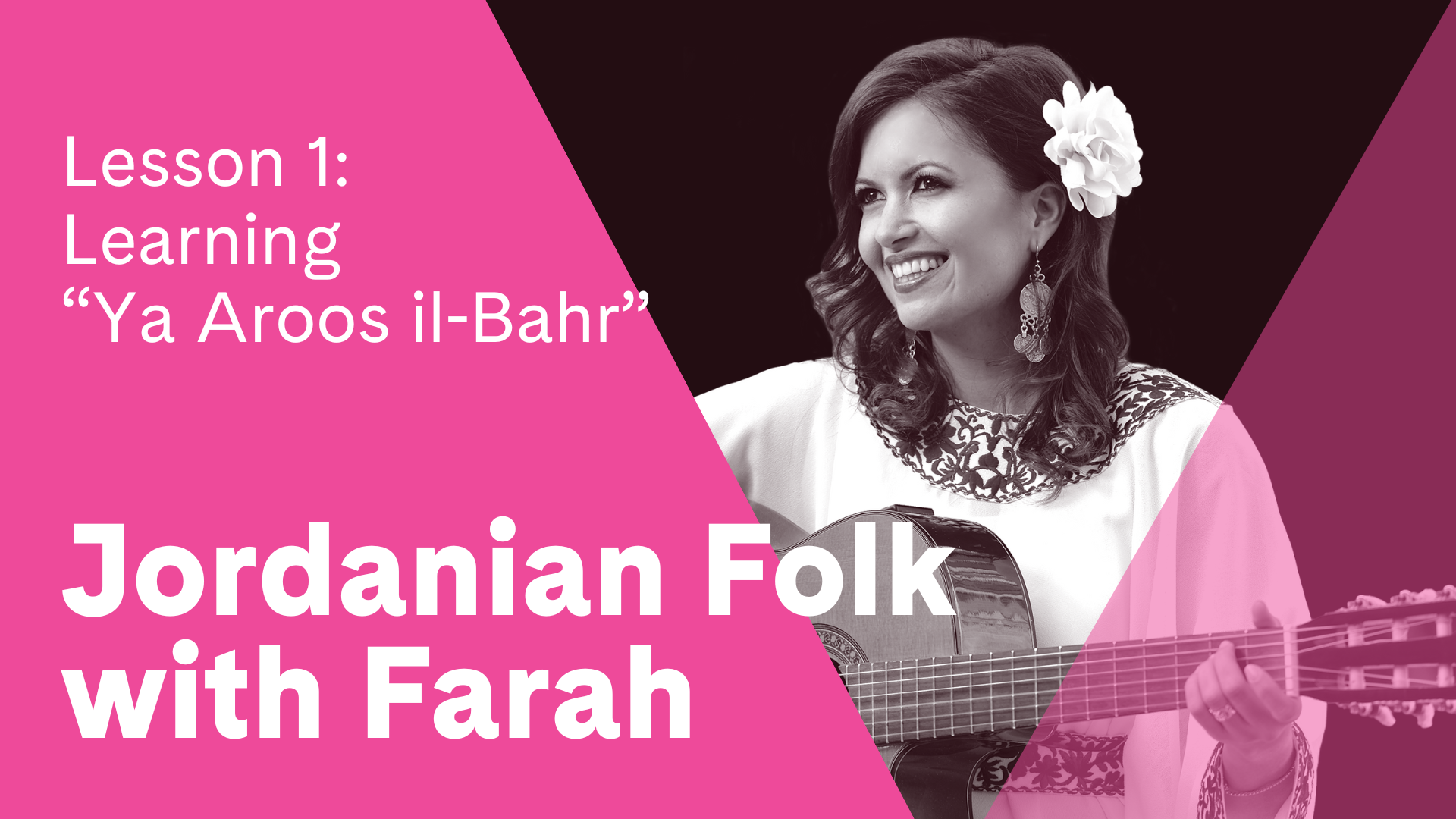Aim: How are rhythm and music used in Jordanian folk music?
Summary: Students will learn to sing and move to the song “Ya Aroos il-Bahr,” and learn rhythmic layers.
Materials: Musical Explorers online audio
Standards: GA: MK-2GM.1, MK-2GM.6, MK-2GM.7, MK-2GM.9, MK-2GM.10 SC: GM.PR.NL-AH.3, GM.RE.NL-AH.6, GM.RE.NL-AH.7, GM.CN.NL-AH.8, GM.CN.NL-AH.9
Vocabulary: bahri, gaseed, rest, and rhythmic layers
“Ya Aroos il-Bahr” is a song from the coast of Jordan that is inspired by the Red Sea. The song paints the picture of Aqaba, which has the distinction of being the only coastal city in Jordan. It details how the city is ornamented with flowers, palm trees, and palm leaves floating in the water. The gulf of Aqaba has its own subculture of bahri music, inspired by the sea and the sounds of the waves. The people of this area are bahri or sea people, and all aspects of their lives are intertwined with the sea; the relationship between the people and the sea is symbiotic.
Sing “Ya Aroos il-Bahr”
- Listen to “Ya Aroos il-Bahr” to hear the full song, Track 3.1.
Track 3.1 – “Ya Aroos il-Bahr” Song
- Learn the lyrics using “Ya Aroos il-Bahr” chorus pronunciation, Track 3.2.
Track 3.2 – “Ya Aroos il-Bahr” Chorus Pronunciation
- Sing the chorus using “Ya Aroos il-Bahr” chorus, Track 3.3.
Track 3.3 – “Ya Aroos il-Bahr” Chorus

“Ya Aroos il-Bahr”
[original lyrics]
Yal agaba ya aroos il bahr
Ya mkalala biklel akhdar
Ya mzawaga bi nakheel ou zahr
La areesk il bahr il ahmar
(x2)
Chorus:
Yal agaba yal agaba
Yal agaba yal agaba
Yal agaba ya aroos il bahr
Yal agaba ya aroos il bahr
Ya zeina yamu shati jamil
Yumu il karam wil haniya
Nismitki tishfi kuli aleel
Wil ga’da ala shat il mayya
Leeki il qulub ti’shag witmeel
Hatal ozool safa ineeya
Leeki il qulub ti’shag witmeel
Hatal ozool safa ineeya
(Chorus)
Hela hela hela hela
Hela hela hela hela
Hela hela hela hela hela hela
Hela hela hela hela hela hela
Yal Agaba ya aroos il bahr
Ya mkalala biklel akhdar
Ya mzawaga bi nakheel ou zahr
La areesk il bahr il ahmar
(x2)
(Chorus)
Ya binti baladi ana bahri
Agbawi wi bahibil ‘om
Hawaki galbi min badri
Wana wana nawi ahibik dom
Wi madam il moj ibtijri
Rah ahibik yom zod ‘an yom
Wi madam il moj ibtijri
Rah ahibik yom zod ‘an yom
(Chorus)
Hela hela hela hela
Hela hela hela hela
Hela hela hela hela hela hela
Hela hela hela hela hela hela
Yal Agaba ya aroos il bahr
Ya mkalala biklel akhdar
Ya mzawaga bi nakheel ou zahr
La areesk il bahr il ahmar
(x2)
(Chorus)
“You are the Bride of the Sea”
[translated lyrics]
O Aqaba you, bride of the sea
You are adorned with green leaves
You are ornamented with palm trees and flowers
You are the bride of the Red Sea
(x2)
Chorus:
O Aqaba, o Aqaba
O Aqaba, o Aqaba
O Aqaba you are the bride of the sea
O Aqaba you are the bride of the sea
O mother of the beautiful shore
Mother of kindness and compassion
Your breeze heals all ailments
Sitting by your waters
To you our hearts are drawn
Feeling alone when far from you
To you our hearts are drawn
Feeling alone when far from you
(Chorus)
Hela hela hela hela*
Hela hela hela hela
Hela hela hela hela hela hela
Hela hela hela hela hela hela
O Aqaba you, bride of the sea
You are adorned with green leaves
You are ornamented with palm trees and flowers
You are the bride of the Red Sea
(x2)
(Chorus)
O daughter of my country I am of the sea
From Aqaba and I love to swim
I loved you from the beginning
And I will love you forever
And as long as the waves are in motion
I will love you day after day
And as long as the waves are in motion
I will love you day after day
(Chorus)
Hela hela hela hela*
Hela hela hela hela
Hela hela hela hela hela hela
Hela hela hela hela hela hela
O Aqaba you, bride of the sea
You are adorned with green leaves
You are ornamented with palm trees and flowers
You are the bride of the Red Sea
(x2)
(Chorus)
*This chant is performed by fisherman hoisting the
anchors from the sea.
Explore Rhythmic Layers in “Ya Aroos il-Bahr”
- In “Ya Aroos il-Bahr,” the eight-beat rhythmic pattern is built from two rhythms layered together; in music we call this rhythmic layers.
- Explain that rhythm is the pattern of sound and silence.
- Learn to clap the first rhythm using Track 3.4 and the second rhythm using Track 3.5.
Track 3.4 – “Ya Aroos il-Bahr” First Rhythm
Track 3.5 – “Ya Aroos il-Bahr” Second Rhythm

- Notice where there are sounds and where there are silences or rests in each rhythm.
- Notice how the two rhythms come together on the first beat.
- Notice how they complement each other, so when they are played together there are no silent beats.
- As a class, clap each of the rhythms along with the full rhythm, Track 3.6.
Track 3.6 – “Ya Aroos il-Bahr” Full Rhythm
- Play “Ya Aroos il-Bahr” Track 3.1 again, this time dividing the class in two and having each group perform one of the rhythms.
Track 3.1 – “Ya Aroos il-Bahr” Song
Dance and Create Movements to “Ya Aroos il-Bahr”
- A traditional movement performed in many songs of the sea in Jordan is a hand motion mimicking the waves. Introduce the movement to your students, which can be found in the accompanying video below.
- During the verses, have your students perform the wave motion throughout the song.
- Read the English translation with your students, asking them to visualize the scene set by the lyrics.
- What else is happening in the song?
- Which other motions can we add to demonstrate some of the lyrics?
- Perform the song again, incorporating both the traditional movements and the new movements that were created. Note that the chant “Hela hela hela hela” is performed by fishermen hoisting their anchors from the sea.
Creative Extension: Write Poetry for Your Neighborhood
- An important component of Jordanian folk music is the role of poetry. The word for poetry is gaseed (referred to as qasid in the broader Arabic world). Poetry is fully integrated into the songs.
- Jordanian folk songs are also directly reflective of the environment. “Ya Aroos il-Bahr” reflects the waves of the sea; city songs have fast rhythms and melodies; and desert songs are slow and laid back.
- Listen again to “Ya Aroos il-Bahr” and review the lyrics with your students.
- How does the poem describe the environment or neighborhood? What words help tell the story?
- What does the poet love about their neighborhood?
- Now ask your students to brainstorm the elements of their neighborhoods that make them distinct.
- How would you describe your neighborhood to someone who doesn’t know it?
- What do you love about your neighborhood, and why?
- They can then illustrate their poems with pictures of their favorite neighborhood places.
- Using SG 20, your students can write short poems about their neighborhoods. The poems can rhyme, or they can be in free verse.
- Then, have students read their poems aloud, thinking about how their spoken word performance might reflect the scene.
- Are the sentences spoken fast or slow? Loud or soft? Are they smooth or jumpy? Why?
- Students can take turns reading their poems out loud with a partner or for the rest of the class and see if they can visualize the neighborhoods being described.
Musical Word Wall
Add bahri, gaseed, rest, and rhythmic layers to the Musical Word Wall.
Audio Tracks
Track 3.1 – “Ya Aroos il-Bahr” Song
Track 3.2 – “Ya Aroos il-Bahr” Chorus Pronunciation
Track 3.3 – “Ya Aroos il-Bahr” Chorus
Track 3.4 – “Ya Aroos il-Bahr” First Rhythm
Track 3.5 – “Ya Aroos il-Bahr” Second Rhythm
Track 3.6 – “Ya Aroos il-Bahr” Full Rhythm

